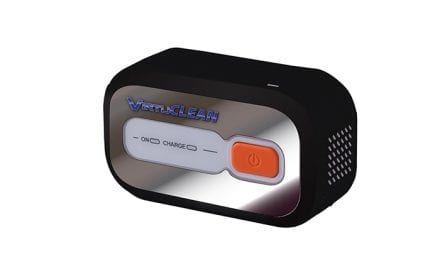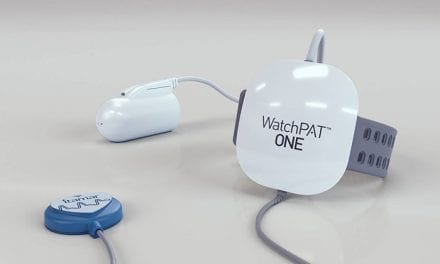The ongoing challenge of getting patients to use their devices is exacerbated by social distancing. But newer interventions show promise.
By Greg Thompson
The global pandemic has naturally funneled medical resources into telemedicine, and many clinicians and manufacturers sense an enduring paradigm shift. From diagnosis to therapy to long-term management, sleep medicine professionals and patients are learning to tame sleep apnea from a distance.
Most sleep medicine professionals are familiar with the steps for remote diagnosis. Home sleep tests for people with suspected obstructive sleep apnea (OSA) were growing pre-pandemic, and the pandemic accelerated that trend. Home sleep tests are designed to be simple to use, and patients can hook them up with basic instructions (written, verbal, video) and/or tech support availability. “Some of these less complex devices can be mailed to patients’ homes as long as there is appropriate oversight to make sure the device is hooked up appropriately, and then returned,” says Dennis Auckley, MD, a professor of medicine at Case Western Reserve University. “As such, some patients do not necessarily need to be seen in person—a telehealth visit can suffice, at least initially—to undergo testing for OSA via a HSAT [home sleep apnea test].”
But diagnosis is but an early step to OSA management. As soon as a patient is prescribed a CPAP or other positive airway pressure (PAP) device, the adherence challenge begins. During the COVID-19 pandemic, more clinicians and durable medical equipment/home medical equipment (DME/HME) companies find themselves in the role of promoting adherence remotely. A variety of technologies can assist in treatment success, as well as a reassuring bedside manner (delivered via phone or video).
[RELATED: Can We Assure Adherence in Patients Titrated by Autoadjusting CPAP at Home?]
The Human Touch
Give credit to newly diagnosed patients: Many can set up their CPAP on their own without assistance.
In a recent single-center prospective trial, all 393 CPAP-naïve patients given a positive airway pressure machine and mask starter kit were able to set themselves up without physical assistance. And, perhaps more surprisingly, their Medicare compliance at 90 days was not different from those who experienced conventional setups (75% for the unaided group versus 77% for the conventional).1 “The principal factor determining ultimate success is patient follow up and support once therapy is initiated,” speculate the study authors.
Study co-author Dominic Munafo, MD, who is chief medical officer at BetterNight (which, among other sleep solutions, facilitates remote setups), elaborates about the importance of patient follow up and support.
BetterNight trains their team of respiratory therapists and sleep techs to meet patients where they are. “The training they receive is standardized so each one of them takes a very similar approach. That way, we make sure we are not doing one technique with one patient and another technique with another,” Munafo says.
The approach includes the fundamentals of motivational interviewing and behavior change, so RTs and RPGSTs can relate to patients. Munafo says, “They also try to set expectations correctly. As an example, when you start somebody on CPAP, everybody knows that that’s a difficult therapy to initiate.
“If you tell people at the very beginning that they’re going to have no problems and it’s easy, then when they have their first issue, they tend to feel like they’re unusual and that they are outside the norm. If you set the expectation that there will be some hurdles but we are there to help, then they’re more likely to cope with the mask leak or a little soreness on the forehead or nose.”
Philips Patient Adherence Management Service (PAMS) also works to motivate and coach patients. During the first 90 days, patients receive one-on-one care through live-call coaching and ongoing sleep apnea education from a team of sleep coaches. PAMS sees about 8,000 new patients a month. Mark Aloia, PhD, global lead for behavior change, sleep & respiratory care at Philips, says, “They are trained regularly by me, and they have a training manual that incorporates some of these techniques like motivational interviewing. They are trained to be good listeners, build good rapport, be very supportive and empathetic. They see levels of adherence that are quite high as well—in the high 70s range is what our last analysis suggested. When you combine DreamMapper [patient-facing app] with our Patient Adherence Management Service, we are up over 80% adherence.”
It’s not only established sleep medicine companies that are finding effective ways to boost adherence. Sleep startups such as Lofta are popping up in an effort to promote remote CPAP use—with a combination of high tech and human interaction. Jay Levitt, CEO and founder of Lofta, says, “There has been a growing demand from people who want to self-advocate their health care and leverage technology. Five years ago, that was just starting to become an interesting phenomenon; now fast forward, largely as a result of COVID, we are finding we have to transact certain aspects of health care virtually. We’re finding out it is actually a better experience than the traditional paradigm.”
After patients are screened and diagnosed remotely, a Lofta sleep coach (who is an on-staff RT) explains their test results over the phone. Patients who need CPAP are remotely started on therapy. “How-to videos and all the resources better be available through technology. That’s how people will typically want to be in control of their experience,” Levitt says. “At the same time, when they want support, you better be there for support. You have to do both. We have real human-to-human support at the critical touch points of the process, and then we leave it to technology for the areas where technology can do probably a better job than a human.”
Eric Mongeau, national sales director at DME/HME provider Aeroflow Sleep, echoes the sentiment that remote services can generate positive outcomes.
“The physician partners we interact with regularly have broadly adopted telemedicine,” he says. “I think it’s here to stay, and I think people are liking that they have a choice in either going to an office or doing a telemedicine encounter with their physician.
“The whole CPAP set up process, whether it’s in person or done via telemedicine, is all around getting that patient to understand why they’re going on CPAP, why they’re being treated for OSA, and what that journey is going to look like.” Aeroflow assigns every patient a dedicated sleep coach.
Mongeau adds, “We were doing telemedicine before it was cool. We use a dedicated telemedicine platform. It can be used on a tablet, a phone, or a desktop computer. (It’s nothing to download.) You get a text or email, you click the link, and the screen opens right in front of you and the clinician is there waiting with a happy face….We’re finding now that our telemedicine set up requests are actually north of 50% at this point.”
[RELATED: Remote CPAP Mask Fittings Are Easier Now, Due to the Launch of New Technologies]
Entry-Level Tech

Technology is also a pillar of remote CPAP adherence.
Remote monitoring, included with most modern PAP devices, is one of the more basic tools available. Keeping a close eye on the data and communicating accordingly with the patient can improve adherence. “Monitoring provides valuable information about a number of parameters, including compliance, how well the PAP is working, and if there is air leaking,” says Auckley, who is also director of the Cleveland-based Center for Sleep Medicine at MetroHealth Medical Center. “Downloads can report such issues as a poor mask, oral leaking, lack of use of the heated humidifier, a low setting, and pressure problems. Many of these issues can be resolved over the phone and do not require in-person visits.”
Carlos M. Nunez, MD, chief medical officer at ResMed, says, “Every CPAP machine that ResMed sells, and almost every major CPAP manufacturer, has connectivity built into their devices. As patients are starting out on the journey of compliance, the devices can monitor how patients are doing and when they use the device. Are they getting the recommended number of hours?”
Not only is the professional monitoring the therapy, patients themselves can also see how they are doing. “I have been a CPAP user for years now,” Nunez says. He uses a ResMed device and ResMed’s patient-facing myAir app. “Every morning it’s one of the first things I look at,” he says. “One of the first numbers is the score that I get on how long I slept, how many times I took the mask on and off (if at all).
“We go from roughly 50% compliance to 70% compliance when you add a connected device. And then it jumps up into the 80% range if you add the app. Getting patients involved and getting clinicians connected to their patients really does help. It was already happening before the pandemic, but the pandemic has given us an opportunity to build on the home sleep testing infrastructure and bolster the whole concept of remote care and monitoring.”
At Lofta, patients are also awarded a nightly sleep score. “People want an instant, continuous feedback loop. There’s almost a gamesmanship to it,” Levitt says. “We even use a sleep score. The way our algorithm works, if you have more than 8 hours, if you have breathing events under 5 per hour, a leak under a certain amount, you get 100 points. So people know that if they don’t sleep 8 hours they’re going to get under 100 points. So a lot of people say, ‘I woke up at 7 hours and 50 minutes, and I laid there for an extra 10 minutes just so I could get 100 points.’ People are very vested in the feedback, and if you’re giving people instantaneous feedback on their efficacy and results, they become more vested. If someone just gets handed a machine and a mask and they’re not getting any feedback, then it’s not reinforcing compliance.”
Patients on Philips devices can download the free DreamMapper app, an adherence tool that boosts more than 2 million users. “You can improve adherence by over 20% just by giving someone this mobile app,” Aloia says. “You don’t even need to do anything else.”
Management by Exception
Because sleep professionals have limited time (and time spent encouraging adherence is in many cases not reimbursable), technological solutions have emerged to allow for management by exception. In the case of OSA management, this means algorithms identify only the patients who are struggling with using CPAP on their own but may become adherent if a sleep professional quickly intervenes.
Some of these algorithms perform with impressive accuracy.
A recent multivariate analysis of a Philips algorithm known as Adherence Profiler bears this out. The study of 457 sleep apnea patients whose data was put into the program found that the significant predictors of CPAP usage on day 90 were only 1) older age, and 2) the Adherence Profiler prediction at day 14.2
Clinicians and DME/HMEs in North America and the European Union who have access to Philips Encore Anywhere or Care Orchestrator cloud-based patient management systems have access to Adherence Profiler. (Adherence Profiler was launched as part of Care Orchestrator in 2015. There’s no added cost, but the user must request for Adherence Profiler to be turned on.)
Philips’ Aloia, who is also an associate professor of medicine at National Jewish Health, says Adherence Profiler is significant because it incorporates data that’s generated across many individuals. “By doing that, we can start to see patterns of use,” Aloia says. “We look at CPAP use as a behavior, and it varies. It’s not just an on or off kind of thing. We can build algorithms that can say who is at risk of having poor adherence down the road.”
Aloia says the algorithmic tool gives clinicians “a red light, green light, yellow light” approach to determine who is in need of additional support.
“That is important from a psychological perspective because it’s a teachable moment,” he says. “We think the early moments of disengagement are teachable moments. Adherence Profiler gives that red flag to say, ‘You should attend to ‘Betty’ because she’s starting to struggle and she’s on the path toward struggling with adherence in the long run.’”
BetterNight too utilizes big data to manage sleep apnea patients by exception. Its proprietary platform is called Clarity. “Clarity tracks thousands of patients by downloading the data from the cloud from major manufacturers like ResMed, Respironics, and Fisher & Paykel,” BetterNight’s Munafo says. “Then we can set our own flags and produce our own reports, so we can determine which people are struggling. Whether they’re having a mask leak, their AHI is elevated, or they are simply not using it—whatever the flag we choose to set, we can then find those individuals….The report goes back to the coaches who can then reach out to the right person, at the right time, with the right intervention.”
As the pandemic continues to surge for at least the short-term, long-term CPAP adherence does not have to suffer. By using human and technological interventions, sleep professionals can continue to support patients with remote interventions.
Greg Thompson is a Loveland, Colo-based freelance writer.
References
- Hevener W, Barnes F, Munafo DA. Feasibility of observed but physically unaided continuous positive airway pressure set ups. Sleep. April 2020;43(suppl_1):A240.
- Sabil A, Le Vaillant M, Stitt C, et al. CPAP data-based algorithm for automatic early prediction of therapy adherence. Sleep Breath. 2020 Sep 25. Epub ahead of print.
Top Illustration 194543132 © Topvectorr – Dreamstime.com




